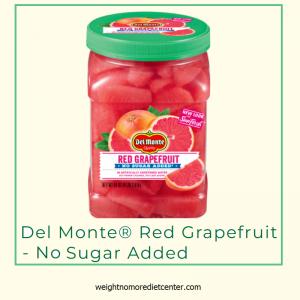Is Canned Fruit OK?
Weight★No★More℠ Diet Center
First, when I say “canned,” I refer to store-bought ready-made fruit in either a can or a jar.
Let me start by saying that when storing fresh fruit pieces for many days, the vitamin C content tends to diminish (the vitamin is easily destroyed by exposure to air). Canned fruit, however, will still retain much of its vitamin C—even when stored for several months—a clear advantage over fresh. Many fresh fruits are also shipped for miles or sit in storage for days before being enjoyed. This also leads to degradation of their nutritional content. And, if you’re on a budget, canned/jarred fruit may cost less than the same amount of fresh fruit.
While it doesn’t have the visual or textural appeal of fresh fruit, canned or bottled fruit can be a good and healthy option if you pay attention to what is in the can or jar. These items are also especially good when you’re craving something out of season. It’s a great way, for example, to enjoy the flavor and sweetness of peaches, mandarin oranges and pineapple all year round. But the other contents in the can affect how good it is for you.
Canned fruit is usually labeled by what type of liquid is canned with the fruit. Typically, there are three kinds of packing liquid: heavy syrup, light syrup and juice. While there isn’t much difference between the calorie counts of fresh and canned fruit, the packing liquid does have an impact.
Heavy syrup contains water, corn syrup and sugar, and it has the most calories of the three. Fruits canned in heavy syrup coat healthy pieces of fruit with loads of added sugar.
Light syrup is made from water and sugar.
Juice-packed fruits are packaged in juice concentrate that has been diluted with water.
Which is the healthiest of the three?
Fruit packed in its juice contains significantly less added sugar than the light- or heavy-syrup and is the healthiest option of the three.
There is, however, a fourth option: in water. And this, of course, is the healthiest version of all, packed in water to keep it fresh and juicy without added sugar. A full cup serving contains just 7 grams of carbs and 6 grams of sugar.
In my house, when it comes to canned fruit, we buy DelMonte jarred fruit. These can be found in the refrigerated part of the Produce section of your supermarket. My husband prefers their fruits in extra light syrup. I prefer the two they offer with no sugar added (Red Grapefruit and Citrus Salad; both of which also come in the extra light syrup). Whichever option you may choose, 1/2 cup = 1 Fruit serving. (I will use a slotted spoon to measure out ½ of the Red Grapefruit, pack it for the office, as well as take a snack-size 2% or $% Breakstone cottage cheese cup. I’ll mix the two for either my mid-morning or afternoon snack at my desk.)
Also, another reason why I prefer the fruit packed in its own juices or water is because some of the vitamin C leaches out of the fruit over time and ends up in the liquid; I can retain some of the otherwise-lost nutrients by using the liquid too. And I do. I drink it straight out of the jar when all the fruit is gone.
Here’s the link to open the DelMonte brochure to see the nutritional data on their six jarred fruits with extra light syrup.






ALL are ½ cup servings, and all are between 60 and 80 calories per serving. The pineapple and mango fruits are slightly higher in carbohydrates so please note:


Bottom line:
Store-bought canned or jarred fruit can certainly be a part of a healthy eating plan, but, as always, it’s important to read labels and choose wisely.
Slimcerely yours℠,



